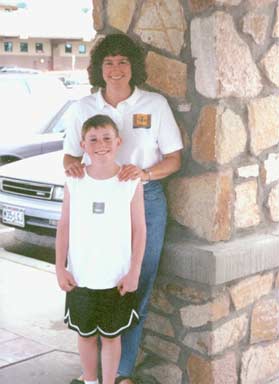
The dream to one day work at NASA’s White Sands Test Facility (WSTF) began with the inclusion of Michael Hallock III in his father’s work at the remote test facility. Michael Hallock Jr. included his family members (daughter Nicola and wife Julie) in his work as an Industrial Engineer in the Safety and Mission Assurance Directorate. Hallock Jr. drew his family members into the discussions centered at the family table, and he volunteered them to participate in education outreach events such as the Mars Settlement Design Competition or Friends and Family Day.
The inspiration to be part of the NASA/WSTF family grew for Hallock III as he helped his father with chauffeuring duties for Astronaut Laurel Clark when she made a guest appearance at WSTF and at the White Sands Space Harbor’s 25th Anniversary Celebration event.
“She inspired me,” says Hallock.
Hallock applied for a scholarship to intern at WSTF while continuing his college studies in Business Computer Information Systems and is one of two interns at the test facility who were awarded an internship from Motivating Undergraduates in Science and Technology Project, or MUST. MUST awards scholarships and internships to undergraduates pursuing degrees in science, technology, engineering, and mathematics (STEM) fields.
The MUST Project is open to all students and is particularly focused on engaging students from underserved and underrepresented groups to enter STEM fields. Hallock’s life-threatening allergy to peanuts was the catalyst for his scholarship.
Before flying to Florida to report on his MUST program internship, Hallock spent some time researching the ongoing problem of serving peanuts on airline flights which may have passengers that have life-threatening allergies. Hallock was able to travel on United Airlines which has elected not to serve peanuts on flights, and cautions passengers about foods that may contain traces of peanuts.
Hallock’s exit summary presentation listed his main project: to rework and revamp the NASA WSTF’s external facing website and to reformat and rework many of the portions of the portal, such as the News and Events portion. The project provided him an opportunity to use skills he acquired in the classroom.
Hallock’s early exposure to the culture of NASA and the inspiration of NASA’s astronauts helped him learn other skills that are only offered by the culture at White Sands Test Facility.
“I fully learned the ‘WSTF way,’ a way that will make me versatile no matter where I go from here. The skills and culture at WSTF are unlike anywhere else within NASA’s domain. I know I am fortunate to have acquired these skills through my father’s advice and through the employees I have worked with the past 10 weeks,” said Hallock. Hallock worked with test facility employees Jim Krupovage and George Alcantar in the NASA WSTF Information Resources Directorate, and contractor employees Jim Dawson and Judy Corbett.
Hallock is studying at New Mexico State University, where he has two more years of study to complete his Bachelor’s degree.
The MUST Project supports 100 undergraduate students with a one-year competitive scholarship of up to one-half of tuition, not to exceed $10,000. Students who maintain the required minimum grade point average will be eligible for a paid internship at a NASA center. Additionally, students will benefit year-round from tutoring, lecture series, and mentoring from STEM faculty and peers.
To learn more about STEM:

























